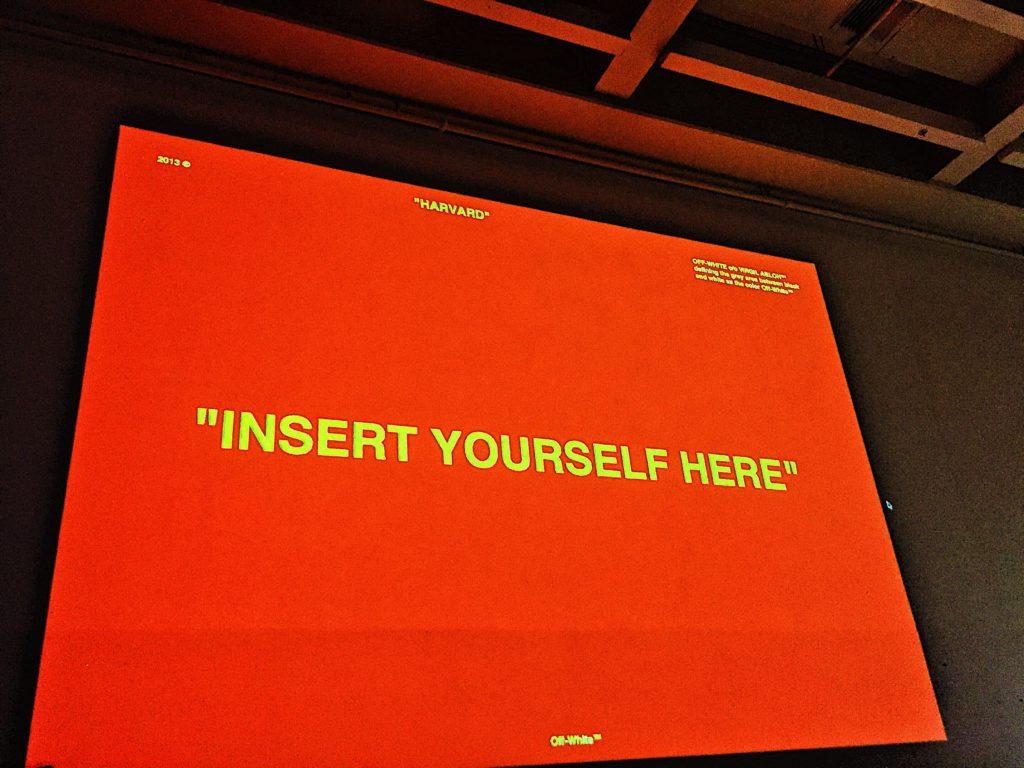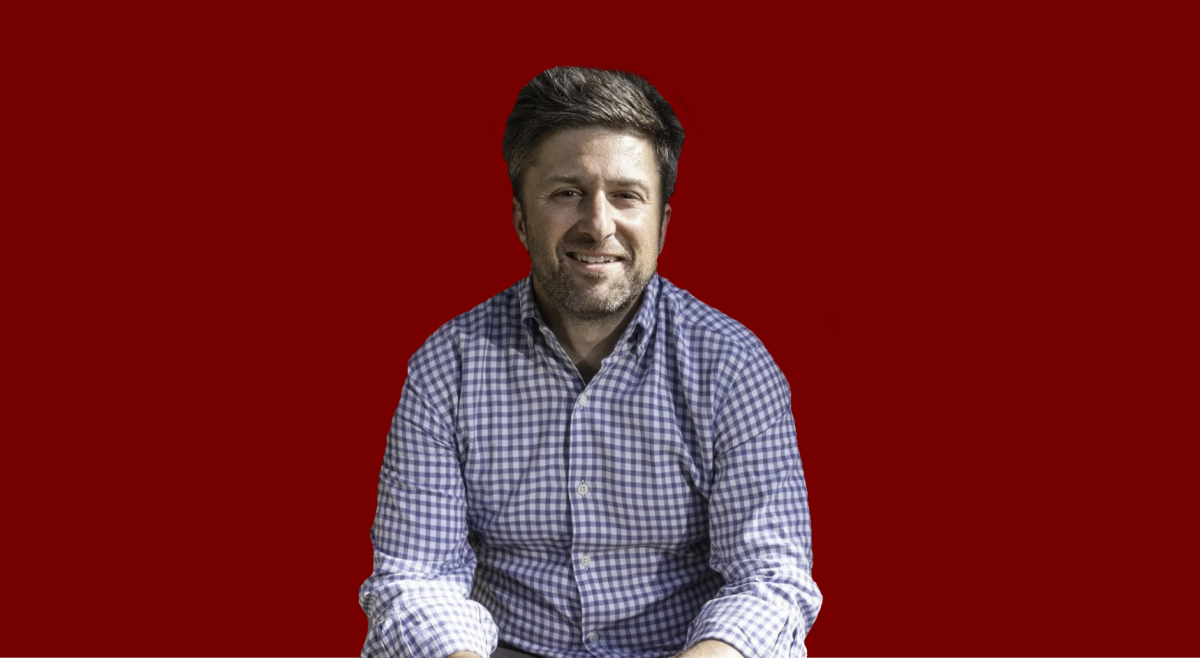When Virgil Abloh walked into the packed lecture hall of the Harvard Graduate School of Design on Thursday night, he was met with thunderous applause. Students and streetwear fanatics decked out in their finest were in the presence of a god, and they could barely contain their excitement. Dressed simply in a light-wash denim jacket, distressed jeans, a black t-shirt, and a pair of his signature off-white Nike sneakers, Abloh walked calmly toward the podium in the front of the room. Abloh stopped for a second, his open and cheery face turning to the audience as he flashed a peace sign and a quick dab—the applause grew even louder.
As he reached the podium, he gave another quick wave, and stowed his carry-on suitcase just behind him, bending down to quickly check its contents. Abloh unzipped it, revealing a cache of shoes that would send any sneakerhead into raptures, before sitting down and allowing Oana Stanescue, a design critic in architecture at the Harvard GSA, to take the stage and introduce him to the crowd. But for this crowd, packed not only with design students but also with the rabid fans of Off-White, the wildly popular clothing brand for which Abloh is both designer and founder, no introduction was required.
But after recounting the story of their first meeting, Stanescue revealed a key insight into Abloh’s work as a designer, explaining that although he might not be “practicing architecture in a traditional sense,” he was an architect at a “different scale.” According to Stanescue, Abloh’s work centers around “the core of creative freedom.”
It was, as Abloh said while taking the podium, a “serious” introduction, but Abloh wasn’t nervous. His voice was calming and lighthearted, and he faced the crowd with complete openness and comfort, shifting back and forth on long legs that were splayed slight off to the side.
As Abloh pulled up his presentation titled “Insert Complicated Title Here,” he remembered to turn off his WhatsApp notification—which had been pinging insistently ever since he entered the room. But for Abloh, a leader in one of the biggest names in fashion, this isn’t unusual, it’s just daily life. Constantly traveling around the world, circling from the major global fashion hubs back to his wife and two children, Abloh conducts practically all his daily operations from his phone—no small feat considering the magnitude of work that he must keep up with.
But for now the noise from the notifications disappeared, and Abloh turned his full attention to the audience, preparing them for a show of “random things on his laptop.” First, however, he wanted to make sure that the audience understood something important. Although Abloh is no longer a student, he feels like “a perpetual kid at school,” and strongly identifies with the struggles that students face. That sense of identification was why he wanted to give this talk completely free of charge, making it open to anyone who wished to attend. He wanted to help them understand “the shortcuts” that he learned while studying something “super practical,” but ultimately finding a career that wasn’t “delineated by a single major.”
And to do that, Abloh debuted a new lecture technique: a series of cheat codes that flashed onto the screen with a bright red slide. Each red slide, which Abloh sprinkled throughout the lecture, contained a question, and if the lister could answer it, they would be one step closer to finding their personal signature, their “DNA.” For Abloh, a person’s earliest memories, his or her “early rational,” are where this signature originates, it’s just defining it later where it gets tricky. Abloh himself worked, and continues to work, at a “feverish pace” to find his signature, which he proudly displayed on the screen in a list pulled straight from his iPhone notes.
For Abloh, his signature comes from seven things. First, his love of avant-garde artist Marcel Duchamp, who rocked the art world with his ‘readymade art,’ an everyday object onto which Duchamp put his signature.
Second is Abloh’s love of talking in quotes to “insert humanity” through conversation. The quotes, although by Abloh’s own admission “a little tired,” are his way of making people laugh. They allow him to speak iconically, saying “two things at the same time.”
Abloh’s DNA is also found in his 3-percent approach, which means that he only ever changes an original design 3 percent, maybe because Abloh himself is a little tired. Here Abloh paused for a moment, flipping one of his sneakers off of his feet and catching it in the air to show the audience. These “slight edited” Air Force One Nikes are the kind of “restrained” design that interests Abloh, who doesn’t really want or need a completely new shoe in the market.
Fourth came Abloh’s approach to compromise, found even in the name of his brand, Off White. It’s a careful balance between streetwear and luxury, black and white, that is at the forefront of his creative focus.
Abloh’s love for imperfection, the “work in progress,” is the fifth tenant of his identity, a love that again stems from the importance of incorporating humanity in art.
“Your hand and your brain will tell you when something’s finished, and then you post-rationalize, make up something afterwards or whatever,” Abloh said.
Number six was Abloh’s requirement for every output to have “a reason to exist.” Following the same rationalization that we don’t need another different pair of shoes saturating the market, Abloh realizes that “over consuming is okay,” and sometimes we just have to say no.
Finally, Abloh’s driving principle is an effort to have the “tourist and the purist meet somewhere.” Designers and thinkers must reach and understand with the everyday consumer, otherwise their work is entirely “self-serving.”
After outlining his personal ethos, Abloh displayed how it shined through in his own work, providing attendees sneak peeks at his upcoming collaboration with the furniture giant Ikea. The upcoming collection was inspired by the humble doorstop, an invention that Abloh considers “genius,” as it could stop a “Boeing 747 from going to here to Tokyo.”
But Abloh didn’t just want attendees to ogle at his work, because by his own admission, he is “not that special.” Instead, he wanted them to imagine themselves in his shoes, imagine themselves taking the work that he had created and spinning it off into something that was, perhaps, 3 percent different from the original. Abloh does not want the next generation of designers, whether they focus on architecture or fashion, to get sucked into the misery that plagues the modern world.
“This is the renaissance,” Abloh said. “Don’t get trapped into this ‘Everything sucks the world is coming to an end’ … It’s exactly the opposite.”
And modern angst certainly wasn’t in the room minutes later when the crowd pelted Abloh with shoes, mobbing him by the podium and begging him to sign their shoes with one of his coveted quotes. He good naturedly laughed and signed as many as he could before he darted out of the room, already onto his next project. Because that work, is after all, his life.
“I take a huge sort of of passion about the creative work that I do, and it’s not work, it’s just living for me,” Abloh said.
Featured Image by Madeleine D’Angelo/Heights Editor







